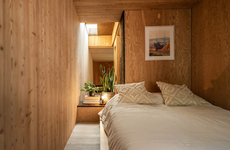
Herzog & de Meuron Incorporate Existing Buildings in Its Project
Kalin Ned — August 8, 2022 — Art & Design
References: herzogdemeuron & dezeen
For its first foray into the urban landscape of Austin, Texas, Swiss architecture studio Herzog & de Meuron brought together brand new mass-timber buildings with existing stores and houses—some of which date back to the 20s. Luckily, it has become a common practice for contemporary architects to aim and preserve and/or repurpose existing structures. In this way, the heritage of the location lives on, while the practice is, in and of itself, largely sustainable, as well.
Spanning an entire city block, the new development is located at the intersection of West Sixth Street and Blanco Street. The proposal includes restaurants, shops, and a hotel. Although the materials for this development have not yet been fully disclosed, the studio has stated that it will rely on a "materials palette aligned with the historic fabric."
Image Credit: Dezeen
Spanning an entire city block, the new development is located at the intersection of West Sixth Street and Blanco Street. The proposal includes restaurants, shops, and a hotel. Although the materials for this development have not yet been fully disclosed, the studio has stated that it will rely on a "materials palette aligned with the historic fabric."
Image Credit: Dezeen
Trend Themes
1. Preservation of Existing Structures - Contemporary architects are increasingly seeking to preserve and repurpose existing structures in their designs, creating opportunities for sustainable development.
2. Mass-timber Construction - The use of mass-timber buildings in urban environments is becoming more prevalent, creating opportunities for cost-effective and sustainable construction.
3. Incorporating Historic Fabric - Architects are finding ways to incorporate historic fabric into their designs through the use of materials and technology, creating opportunities for unique and culturally rich developments.
Industry Implications
1. Architecture - The architecture industry can take advantage of the trend towards preserving and repurposing existing structures by offering innovative design solutions that promote sustainability.
2. Construction - The construction industry can capitalize on the trend towards mass-timber construction by investing in new technologies and materials, creating opportunities for cost-effective and sustainable development.
3. Hospitality - The hospitality industry can leverage the trend towards incorporating historic fabric in design by offering guests unique and culturally rich experiences through historic building conversions and adaptive reuse projects.
3.3
Score
Popularity
Activity
Freshness























